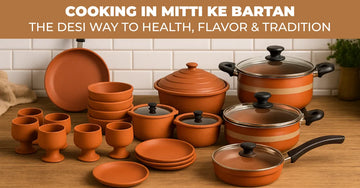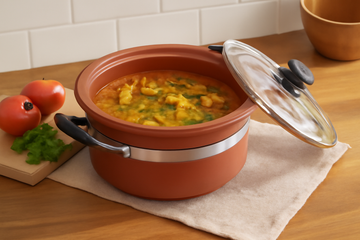Mitti ke bartan (clay cookware) are not just a tool for cooking; they carry deep spiritual and cultural significance, especially in Pakistan. These traditional kitchen essentials have been part of South Asian culture for centuries, passed down through generations. While modern kitchens now boast an array of stainless steel, non-stick, and other high-tech cookware, mitti ke bartan still hold a unique place in the hearts of many families. Their spiritual value, coupled with their role in preserving food culture, continues to make them a cherished part of Pakistani kitchens.
The Historical Connection of Mitti Ke Bartan with Pakistani Culture
In Pakistan, the use of mitti ke bartan is deeply intertwined with history, tradition, and spirituality. The use of clay pots and vessels can be traced back to ancient civilizations, including the Indus Valley Civilization, one of the oldest urban cultures known for its advanced cooking techniques. The very essence of cooking in mitti ke bartan connects us to our roots and ancestral practices, evoking a sense of nostalgia for simpler times.
Historically, clay was the material of choice for everyday kitchen items. Clay pots, jars, and containers were used for everything, from cooking meals to storing water and grains. In rural areas, where modern cookware was either too expensive or simply unavailable, mitti ke bartan were the go-to choice for cooking meals over wood or coal stoves. Their ability to evenly distribute heat and retain moisture made them perfect for long cooking times, especially for stews, curries, and rice dishes that form the core of Pakistani cuisine.
Spiritual Significance in Pakistani Kitchens
The spiritual significance of mitti ke bartan in Pakistani kitchens is rooted in their connection to the earth. In Islam, the concept of taharah (purity) holds immense importance, and natural materials like clay are considered pure, untainted by artificial substances. Cooking with mitti ke bartan aligns with the belief in using natural and unprocessed materials to nourish the body and soul.
Furthermore, cooking in mitti ke bartan is often viewed as an act of mindfulness and connection with nature. The slow, deliberate process of cooking in clay pots reflects the core spiritual value of patience. As the clay absorbs and evenly distributes heat, it transforms raw ingredients into nourishing food, a process akin to the way patience transforms one’s inner self. It’s a metaphor for the slow journey of spiritual growth — steady, grounded, and rooted in the earth’s energy.
The food prepared in these traditional vessels is often seen as more than just sustenance; it is a form of offering or gratitude. Many families, especially in rural or spiritual communities, consider cooking in mitti ke bartan as a way to connect with their ancestors and express respect for the land and its resources. The entire process — from the preparation of the meal to the act of serving it — becomes a sacred ritual.
Cultural Significance: A Reflection of Heritage
Mitti ke bartan are not just cookware; they are a symbol of cultural pride and heritage. In many Pakistani homes, especially in rural areas, the presence of clay pots in the kitchen is a reminder of the simple, humble life of the past. They are passed down through generations as heirlooms, carrying with them stories and memories of families long gone. A clay pot is not just a utensil; it’s a piece of family history.
In rural Pakistan, cooking in mitti ke bartan is not only about tradition but also about keeping the culture alive. The use of these utensils during festivals, gatherings, or family meals strengthens the bond between generations. Whether it’s a wedding feast, Eid celebration, or a simple family gathering, mitti ke bartan hold a special place in the heart of the occasion, evoking warmth, nostalgia, and a connection to cultural roots.
Regional Significance of Mitti Ke Bartan in Pakistani Cuisine
Each region of Pakistan has its own unique approach to cooking with mitti ke bartan, showcasing the diversity of flavors and culinary traditions across the country. In the Punjab region, for instance, handi (clay pots) are commonly used for cooking rich curries and slow-cooked meat dishes like karahi and nihari. These pots help retain the flavors of the spices, creating deep, rich, and aromatic dishes that are a hallmark of Punjabi cuisine.
In Sindh, mitti ke bartan play a crucial role in making traditional dishes like Sindhi biryani and sindhi karhi. The earthy flavor imparted by the clay enhances the robustness of these dishes, making them even more memorable. In Pashtun areas, clay vessels are often used to cook slow-braised meats, with the slow heat of the clay ensuring that the meat becomes tender and flavorful.
In each region, mitti ke bartan carry the essence of local food culture and are closely tied to the way food is prepared and served. These clay pots are used not only for cooking but also for serving meals, emphasizing the importance of hospitality in Pakistani culture.
Mitti Ke Bartan as a Symbol of Sustainability and Eco-Friendliness
In today’s world, where sustainability is more important than ever, mitti ke bartan offer a natural, eco-friendly alternative to metal and plastic cookware. Made from natural clay, these pots are biodegradable and do not contribute to the pollution caused by synthetic materials. The use of mitti ke bartan reflects a sustainable lifestyle, where families embrace the natural world and its resources.
As the world faces the challenges of climate change and environmental degradation, there’s a growing movement towards eco-friendly living. Mitti ke bartan, in this context, are a perfect embodiment of sustainable living. They are durable, long-lasting, and can be passed down for generations, reducing the need for disposable, non-recyclable cookware.
Mitti Ke Bartan in the Modern Kitchen
In recent years, there has been a resurgence in the popularity of mitti ke bartan, even in modern kitchens. While many people still use stainless steel, aluminum, and non-stick cookware, there is a growing trend of incorporating clay cookware into the daily cooking routine. This is especially true in urban areas, where people are looking for healthier, more natural ways to prepare food.
Today, many Pakistani households have a mix of traditional mitti ke bartan and modern cookware. The traditional pots, pans, and handis are often used for slow-cooked meals, biryanis, or stews, while more modern pans may be used for quick frying or stir-frying. The ability to combine the best of both worlds — tradition and convenience — has made mitti ke bartan a valuable addition to contemporary kitchens.
Conclusion
Mitti ke bartan are more than just cooking tools in Pakistani kitchens; they represent the spiritual and cultural soul of the nation. These clay pots are a symbol of tradition, history, and sustainability. They connect generations, serve as a link to our ancestral past, and carry profound spiritual significance. For many, cooking with mitti ke bartan is not just a way to prepare food but a way to honor the earth, the culture, and the spiritual journey of nourishing both body and soul.
In a world that is increasingly dominated by fast, convenient cooking methods, mitti ke bartan offer a reminder of the slow, mindful process of preparing food with love, respect, and gratitude. Whether it’s a steaming pot of nihari, a fragrant biryani, or a simple dal, food cooked in mitti ke bartan is more than just a meal; it’s a celebration of culture, spirituality, and heritage. So, the next time you find yourself in the kitchen, consider embracing the spiritual and cultural significance of mitti ke bartan — a practice that brings us closer to our roots and our traditions.



